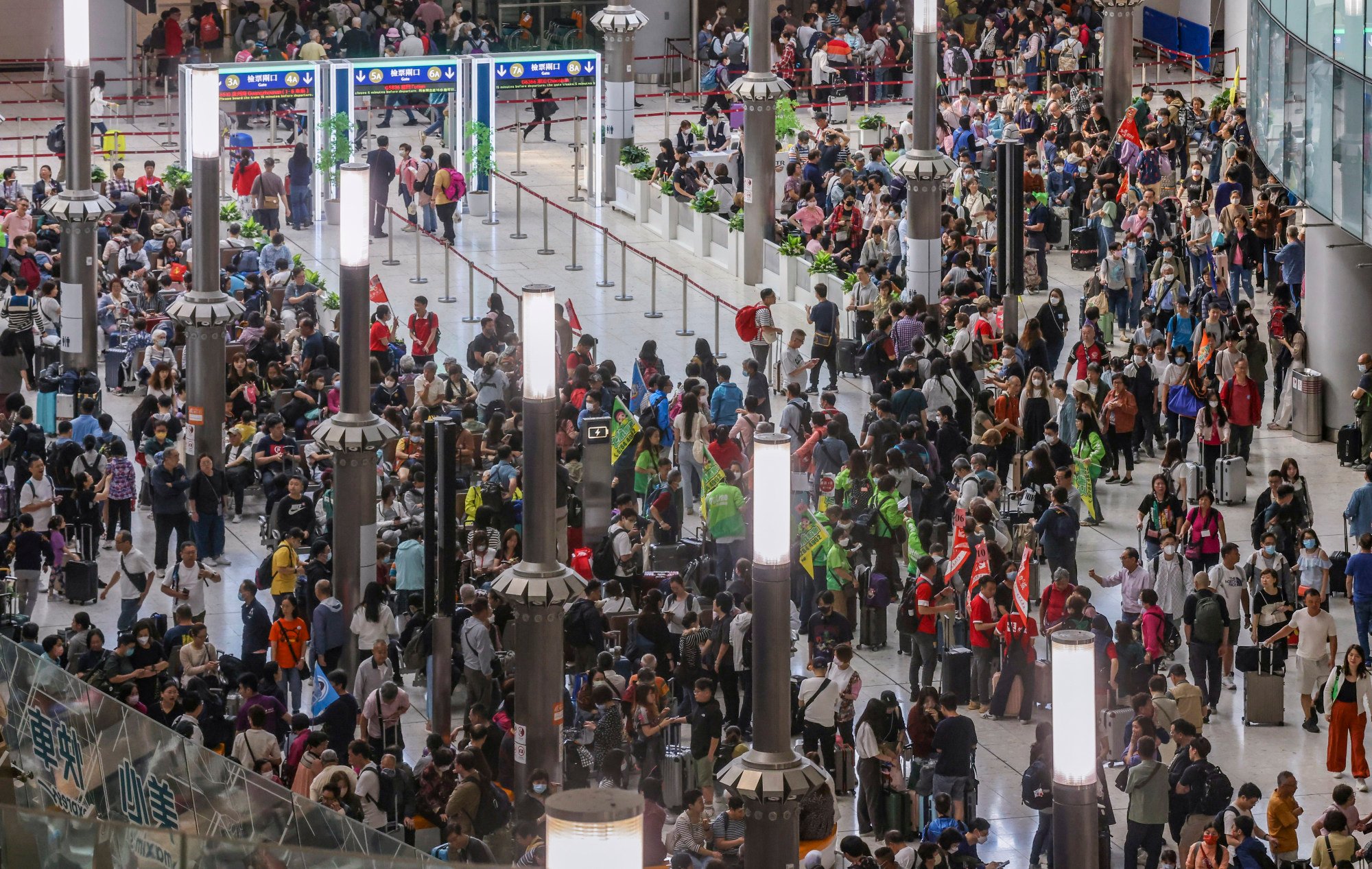
Hundreds of thousands of Hongkongers swamp border crossings as they leave city on first day of Easter holiday
- Official figures show at least 589,654 residents left city across all border points as of 4pm on Friday
- Long queues seen at city land-based checkpoints, including Lo Wu crossing and West Kowloon high-speed rail terminus
More than 681,000 people flooded out of Hong Kong across its border checkpoints on Friday as they left the city in droves on the first day of the Easter holiday, more than seven times the number of visitors that trickled into the city from mainland China.
Immigration Department figures showed that at least 681,412 Hong Kong residents had left the city across all border points by 9pm on Friday and inbound traffic stood at 93,219.
The outbound figure surpassed the 2018 pre-pandemic figure of 593,383 on the first day of the holiday.
But the number of inbound visitors trailed behind the full-day count recorded on the same day that year, which stood at 148,324.
Long queues were seen at various land checkpoints throughout the day, including the Lo Wu crossing and the West Kowloon high-speed rail terminus.
The MTR Corporation was forced to deploy extra staff to stations along the East Rail line in the morning to cope with the surge in passenger numbers and the company warned travellers to expect delays.

The Transport Department issued similar warnings just after 10am as the increased traffic also caused delays for motorists travelling over the Shenzhen Bay and Hong Kong-Zhuhai-Macau bridges.
The department said the land checkpoints would be “very busy” on Saturday morning and warned people to expect a longer waiting time for public transport.
Among the travellers at the West Kowloon high-speed railway station was Derek Choi Cheuk-lun, who works in the finance industry.
He said he would spend three days in Shenzhen and he added the main purpose of his trip was to “eat, drink, have a massage and chill”.
Unsure how to spend your Easter public holiday? Hong Kong offers events galore
“After all, things in Hong Kong are expensive,” 34-year-old Choi said. “Spending holidays in Shenzhen is way more cost-effective.”
Emily Ng Siu-Lai, the owner of a ukulele store, said she would go on a business trip to Huizhou as her shop in Tsim Sha Tsui got few customers at weekends and on public holidays.
“I think most Hongkongers opt to go north when they have time. My business is poor during holidays,” she said.
Public servant Paul Tong Ka-wai and his family were on their way to Jiangmen for the four-day holiday.
“I think the service quality in mainland China is better than that offered in Hong Kong, which makes you feel like you’ve spent your money well,” the 51-year-old said.

A Post check found that, by 3pm, almost all Shenzhen and Guangzhou-bound train tickets for before 7pm on Friday were sold out.
A railway station staff member, who gave his name only as Wong, said that passenger traffic at the terminus was 30 per cent higher than last Saturday.
Simon Wong Ka-wo, president of the Hong Kong Federation of Restaurants and Related Trades, said he expected a 30 per cent decline in turnover for local catering businesses over the holiday.
“It looks as if Hong Kong has been hollowed out at the moment,” he said. “Although there are some large-scale art events [enticing travellers to come], they are inadequate.
“Many mainland cities have rolled out a wide array of activities and incentives to entice travellers. It is a headache trying to get Hongkongers to spend the holiday at home.”
He added that the sector’s concerns would intensify this year as Hongkongers might extend their break because of the Ching Ming Festival holiday next Thursday.
Hong Kong expects 11 million border crossings at Easter and Ching Ming Festival
Easter Sunday falls on March 31 and the traditional Chinese tomb-sweeping day to honour ancestors is on April 4. Easter is not a public holiday on the mainland.
The city is at present hosting Art Basel Hong Kong, Asia’s largest contemporary art fair at the Convention and Exhibition Centre, along with Art Central at the Central Harbourfront.
Authorities have also launched the Art@Harbour project, displaying large-scale outdoor artworks on both sides of the Victoria Harbour.
At the section of Nathan Road that leads to the Avenue of Stars in Tsim Sha Tsui – one of the major attractions in the city – the Post observed the flow of people was much smaller than the usual numbers on a Saturday.
A woman who sells ice cream and water at an entrance to the avenue said sales were just a quarter of what they were last Saturday.
“By 5pm last Saturday, I made nearly HK$4,000. Now I have only around HK$1,000,” the 50-year-old, who identified herself only as Chiu, said.

Hong Kong Tourism Association executive director Timothy Chui Ting-pong said he expected a surge in mainland tourists during next month’s Labour Day “golden week” holiday.
He also hoped that Beijing would add more mainland cities to the list of ones whose residents can visit Hong Kong as solo travellers.
More than 1.71 million visitors entered the city during the five-day Labour Day holiday last year. Mainland tourists accounted for 625,538, or 36.6 per cent of the total.
Mainland arrivals beat earlier expectations, but still fell short of the 997,663 mark set over four days in 2019.
The holiday will run from May 1 to 5 this year.
The Immigration Department earlier estimated that visitors and residents would make 11 million inbound and outbound trips over the holiday weekend and Ching Ming Festival.
The department said it expected heavy traffic at land crossings, with about 207,000 people using the Lo Wu checkpoint each day, 169,000 at the Lok Ma Chau Spur Line and 143,000 taking the Hong Kong-Zhuhai-Macau Bridge route.
Additional reporting by Fiona Chow


